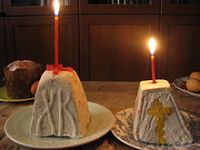How Easter is calculated
I would defy anyone to declare that the calculation of Easter is easy. It used to be based on the rough calculation of the Sunday in the week when the Jewish Week of Unleavened Bread (the Passover Week) occurred. In 325 it was decreed that Easter would fall on the first Sunday after the first full moon after the Spring equinox. But...

The Week of Unleavened Bread symbolizes the time when the Jewish slaves were liberated from slavery in Egypt and had no time to leave the dough to rise. Pesakh (Passover) commemorates this event (c. 1.300 BC), which begins on the fifteenth day of the Hebrew month of Nisan, a fertility benchmark when barley is ripe. The early Christian church celebrated Easter (the Passion and Resurrection of Christ) around this time - Christians would ask the Jews in their neighborhood when the Week of Unleavened Bread would occur (the calendar date changes from year to year) and celebrated their Easter on the Sunday of the same week.
The question was that different Jewish and Christian communities calculated the date in different ways and it became an event which more or less coincided with the rebirth of agricultural life in Spring in the northern hemisphere, the day depending on where you lived, and so at the Council of Nicaea in 325 AD it was established that the first Sunday after the first full moon on or after the Spring (Vernal) Equinox would be Easter Sunday, and from there, the period of Lent would be counted (backwards, starting from Easter Sunday and going back 40 days).
If this first full moon falls on a Sunday, Easter is one week later. This, according to the Gregorian calendar, so Easter falls between March 22 and April 25. But the complication comes for those churches which do not use the Gregorian, but rather, the Julian calendar, which is the case of the Orthodox Christian churches. Here, there are 19 possible dates for the Easter Full Moon between March 21 and April 18 because not only is the Julian calendar out of synchronization with the Gregorian by 13 days (dates are 13 days later), the computation (Computus) of the Paschal full moon is also different.
Lunar months are 29 or 30 days long, so the lunar year is shorter than the solar one by 11 days. The synodic month is the average length of the lunar month and is precisely 29.530588853 days long and there are 12 synodic months in the lunar year. The days in excess in the solar year (over the lunar one) are called epacts, and to find the corresponding day to any (solar year) day in the lunar year, one adds the epact to the date in the solar year. When the epact reaches 30 or above, an intercalary month has to be inserted into the lunar year cycle, then the figure 30 is subtracted from the epact for the cycle to repeat from zero.
This is the so-called Metonic cycle, which repeats every 19 years (so there are only 19 possible dates for the Paschal full moon from 21 March to 18 April inclusive) but the calendar cycle is not exact, so once every nineteen years, a lunar leap day has to be inserted to make the adjustment. The Eastern Orthodox Churches do not insert that day and so there is a difference between the ecclesiastical full moon and the astronomical one. Therefore the Orthodox Easter is not always 13 days after the non-Orthodox Christian churches because the starting point, it depends whether the ecclesiastical moon in any particular year is synchronized with the astronomical full moon.
What does Easter mean?
Easter eggs, chocolate bunnies, brought to the UK and the USA by German immigrants. And center stage enter the pagan Goddess of Fertility and Spring - Eastre, celebrated at pre-Christian (Pagan) fertility festivals around this time of year (beginning of Spring) depicted in rock engravings holding a rabbit (fertility) and an egg (eternity, no beginning and no end).
It is a time of Resurrection, the restarting of the cycle of agriculture, of life, a time of sowing, a time of planting and a time of celebration that the Winter Spirit of death (symbolic death of the agricultural cycle) has departed. The Fertility Festival is the antithesis of the first Festival of Light, Hallowe'en, which marks the end of the agricultural cycle and the coming of darkness.
And for those Europeans who say that Hallowe'en is a "stupid American festival" here is the rub. To be an American Festival, it either had to be born the other side of the Atlantic or else was taken there by Europeans, who since dropped the customs and had them re-introduced centuries later. In fact, Hallowe'en comes from "evening" before the Saints (who wear halos round their heads, Hallow's evening) and was the mark by which time the agricultural chores had to be finished. It was a tremendously important festival in Medieval Europe.
The symbolic burning of scarecrows abounds in different parts of Europe either at Hallowe'en (the "Guy" in the UK), during the Festivals of Light throughout Winter (Saint Martin's Day in November, not to mention Christmas and New Year and Epiphany) or at Easter.
So these are not German festivities or American festivals, they are Universal rites based around common human values - respect for life, the celebration of resurrection, the eternal cycle of new hopes for a tomorrow bathed in light... however dark the nights may be. This eternal quest to protect and worship life has been present since humankind began communicating through engravings - placing a funeral stone on the breast of the deceased with zigzag lines representing waves or the feathers of the night-Goddess, the Owl (brought by the Moon Goddess), also representing waves. Waves are water, water is life.
Paskha in Russia
In Russia, people boil eggs and color them for Easter (Paskha), drawing designs or patterns on top of the coloured paint. Red-coloured eggs represent the Blood of Christ. Good Friday is called Strastnaya Pyatnitsa and Easter Sunday is Pashalnoye Voskresenye, Svetloye or Khristovo Vonkresenye, after the Easter Service at Church on Saturday. At midnight the priest says Khristos Vosgres! (Christ is risen!) and the congregation says Voistinu Vosgres! (Truly He is risen!)

Photo: Paskhas in the foreground, Kulich and eggs in the background
Whether or not they went to Church service, on Easter Sunday people say this and perform the Kiss of Peace or Khristosovanie (Kissing three times).
Easter Sunday is celebrated with the Easter Breakfast, which ends the Great Lenten Fast, and which consists of many dishes. Typical dishes are Kulich (Easter Bread, symbolizing the Body of Christ, with a cross on top) and Paskha, Easter Cake (a pyramid-shaped dish made from cheese curds).
Charitable offerings are made to the poor, needy and orphanages.
Timothy Bancroft-Hinchey
Pravda.Ru
(timothy.hinchey@gmail.com)
*Timothy Bancroft-Hinchey has worked as a correspondent, journalist, deputy editor, editor, chief editor, director, project manager, executive director, partner and owner of printed and online daily, weekly, monthly and yearly publications, TV stations and media groups printed, aired and distributed in Angola, Brazil, Cape Verde, East Timor, Guinea-Bissau, Portugal, Mozambique and São Tomé and Principe Isles; the Russian Foreign Ministry publication Dialog and the Cuban Foreign Ministry Official Publications. He has spent the last two decades in humanitarian projects, connecting communities, working to document and catalog disappearing languages, cultures, traditions, working to network with the LGBT communities helping to set up shelters for abused or frightened victims and as Media Partner with UN Women, working to foster the UN Women project to fight against gender violence and to strive for an end to sexism, racism and homophobia. He is also a Media Partner of Humane Society International, fighting for animal rights.
Subscribe to Pravda.Ru Telegram channel, Facebook, RSS!




